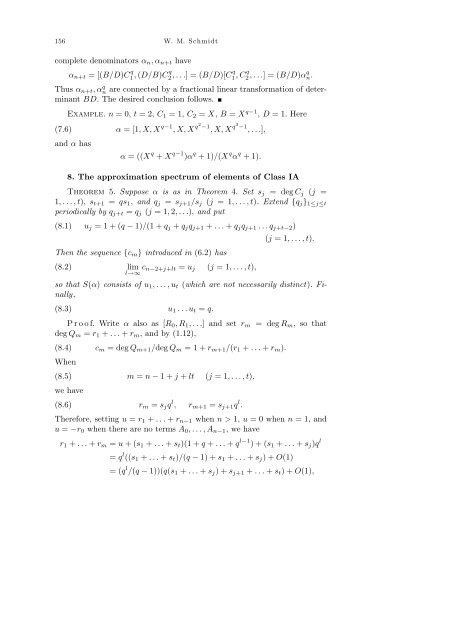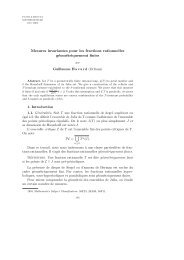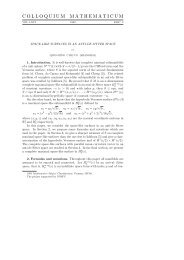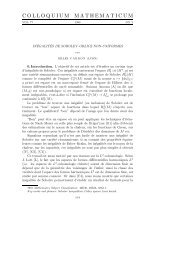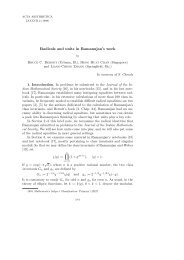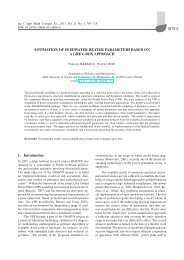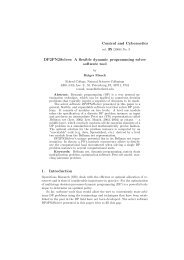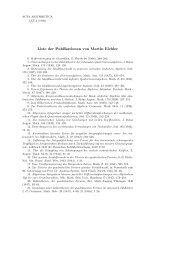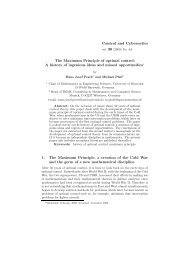On continued fractions and diophantine approximation in power ...
On continued fractions and diophantine approximation in power ...
On continued fractions and diophantine approximation in power ...
You also want an ePaper? Increase the reach of your titles
YUMPU automatically turns print PDFs into web optimized ePapers that Google loves.
156 W. M. Schmidt<br />
complete denom<strong>in</strong>ators αn, αn+t have<br />
αn+t = [(B/D)C q<br />
1<br />
, (D/B)Cq<br />
2<br />
, . . .] = (B/D)[Cq 1 , Cq 2 , . . .] = (B/D)αq n.<br />
Thus αn+t, α q n are connected by a fractional l<strong>in</strong>ear transformation of determ<strong>in</strong>ant<br />
BD. The desired conclusion follows.<br />
Example. n = 0, t = 2, C1 = 1, C2 = X, B = X q−1 , D = 1. Here<br />
(7.6) α = [1, X, X q−1 , X, X q2 −1 , X, X q 3 −1 , . . .],<br />
<strong>and</strong> α has<br />
α = ((X q + X q−1 )α q + 1)/(X q α q + 1).<br />
8. The <strong>approximation</strong> spectrum of elements of Class IA<br />
Theorem 5. Suppose α is as <strong>in</strong> Theorem 4. Set sj = deg Cj (j =<br />
1, . . . , t), st+1 = qs1, <strong>and</strong> qj = sj+1/sj (j = 1, . . . , t). Extend {qj}1≤j≤t<br />
periodically by qj+t = qj (j = 1, 2, . . .), <strong>and</strong> put<br />
(8.1) uj = 1 + (q − 1)/(1 + qj + qjqj+1 + . . . + qjqj+1 . . . qj+t−2)<br />
Then the sequence {cm} <strong>in</strong>troduced <strong>in</strong> (6.2) has<br />
(8.2) lim<br />
l→∞ cn−2+j+lt = uj (j = 1, . . . , t),<br />
(j = 1, . . . , t).<br />
so that S(α) consists of u1, . . . , ut (which are not necessarily dist<strong>in</strong>ct). F<strong>in</strong>ally,<br />
(8.3) u1 . . . ut = q.<br />
P r o o f. Write α also as [R0, R1, . . .] <strong>and</strong> set rm = deg Rm, so that<br />
deg Qm = r1 + . . . + rm, <strong>and</strong> by (1.12),<br />
(8.4) cm = deg Qm+1/deg Qm = 1 + rm+1/(r1 + . . . + rm).<br />
When<br />
(8.5) m = n − 1 + j + lt (j = 1, . . . , t),<br />
we have<br />
(8.6) rm = sjq l , rm+1 = sj+1q l .<br />
Therefore, sett<strong>in</strong>g u = r1 + . . . + rn−1 when n > 1, u = 0 when n = 1, <strong>and</strong><br />
u = −r0 when there are no terms A0, . . . , An−1, we have<br />
r1 + . . . + rm = u + (s1 + . . . + st)(1 + q + . . . + q l−1 ) + (s1 + . . . + sj)q l<br />
= q l ((s1 + . . . + st)/(q − 1) + s1 + . . . + sj) + O(1)<br />
= (q l /(q − 1))(q(s1 + . . . + sj) + sj+1 + . . . + st) + O(1),


